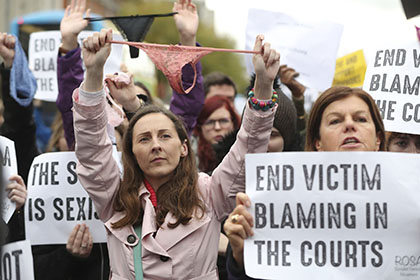
[dropcap]U[/dropcap]sing a person’s underwear in a rape trial to insinuate their consent is outrageous and should never be allowed. The recent Cork trial in which this occurred is a reminder that it needs to come to an end.
The case involved a 27-year-old man accused of raping a 17-year-old girl in a laneway in Cork. He was found not guilty of rape at the trial in November. The case drew attention from all over the world and protests were held across Ireland with participants holding up their underwear and signs saying: “This is not consent.”
The underwear was brought up by barrister Elizabeth O’Connell in her closing address to the jury in the trial, according to the Irish Examiner.
“Does the evidence out-rule the possibility that she was attracted to the defendant and was open to meeting someone and being with someone? You have to look at the way she was dressed. She was wearing a thong with a lace front,” O’Connell said.
Would a man’s underwear ever be shown in a rape trial? A lawyer would never stand up and say in court: “You have to look at the way he was dressed. He was wearing a pair of boxer briefs.”
The type of underwear a woman wears does not reflect her status of consent. A hint of lace is not a verbal agreement. Although the reaction has been uproarious around the country and world, it is another reminder that issues surrounding consent still exist.
In 2016, a Eurobarometer survey showed that 9% of Irish people believed a person voluntarily going home with somebody or wearing “revealing, provocative or sexy clothing” justified sex without consent, according to TheJournal.ie. People may disagree with using underwear in court, but it is still pertinent to remember that clothing in any form is not indicative of consent.
The rugby rape trial in Belfast earlier this year also drew controversy over the way in which it was dealt and a recent review has been published about the handling of sexual assault cases in Northern Ireland as a result. In this case, the alleged victim’s underwear was also brought forward in front of the court, according to the Irish Times.
The hashtag ThisIsNotConsent has been used by people across the world showing their underwear online. Ruth Coppinger TD also held up a thong in the Dáil to further the message.
As a result, real change is being considered. Taoiseach Leo Varadkar said on This Week in Politics that “we have asked a very eminent person to examine, particularly around the rules of evidence as to what kind of evidence can or cannot be admitted in court”.
There should have been no need for any protest or uproar because it should have never been allowed in the first place to use underwear as evidence of consent in court.
Although outrage at this sort of thing is good and necessary, real change is needed in the courts system in terms of not allowing underwear to be used as a proof of possible consent. A lacy thong does not equal a consensual yes.
Orla Dwyer
Image Credit: Niall Carson PA/AP


